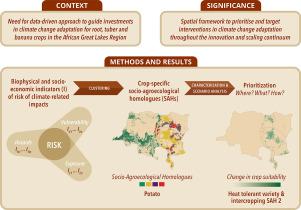Agricultural Systems ( IF 6.1 ) Pub Date : 2022-09-05 , DOI: 10.1016/j.agsy.2022.103464 Elke Vandamme , Rhys Manners , Julius Adewopo , Graham Thiele , Michael Friedmann , Philip Thornton

|
CONTEXT
Given the significance of climate change impacts on farming communities, large investments are made by research and development actors, including farmers themselves, to adapt agricultural systems. A data-driven approach is required to guide these investments and maximize their impact. In the African Great Lakes Region (GLR), root, tuber and banana (RT&B) crops are a vital component of smallholder farming systems, but little is known about strategies to mitigate climate change impacts on these crops.
OBJECTIVE
The objective of this study was to develop a spatial prioritisation and targeting framework based on the risk of climate-related impacts to guide research investments and prioritisation in CSA for RT&B crops in the GLR.
METHODS
Climate change impact data on crop suitability were layered onto other spatially-explicit biophysical and socio-economic data to map clusters of homologous regions, called socio-agroeocological homologues (SAHs). The SAHs were defined by the risk of climate-related impacts, resulting from the interaction of hazards, exposure and vulnerability. The framework was applied to RT&B crops (banana, potato, cassava and sweetpotato) in the African GLR. Its utility was illustrated by elaborating adaptation scenarios for selected SAHs of one long-duration (banana) and one short-duration (potato) RT&B crop.
RESULTS AND CONCLUSION
Four SAHs were identified for banana, potato and sweetpotato and five for cassava. For each crop, SAHs were prioritised for investment in climate change adaptation based on the level of risk of climate-related impacts. Scenario analysis showed that the introduction of drought-tolerant varieties would increase suitability for banana from 0.30 to 0.47 under baseline conditions and from 0.54 to 0.71 under future climates in a prioritised SAH with low to moderate suitability for typical varieties. For potato, the introduction of heat-tolerant genotypes, intercropping with legumes or the combination of both would allow compensating negative impacts of climate change on crop suitability in two SAHs representing important mid-altitude potato growing areas, from an average of −0.19 and −0.16 to an average of up to +0.25 and + 0.15 respectively. Scaling approaches should consider the difference in socio-economic conditions between the two SAHs.
SIGNIFICANCE
We envision the framework to be useful for a diverse range of users throughout the innovation and scaling continuum to understand where climate change impacts are expected to be most severe, what type of innovations are needed to help farmers adapt, and how these innovations should be scaled to enable uptake by considering socio-economic drivers of adoption.
中文翻译:

非洲大湖区块根、块茎和香蕉作物适应气候变化的研发投资战略:空间优先排序和目标框架
语境
鉴于气候变化对农业社区的影响的重要性,包括农民自己在内的研发参与者进行了大量投资以适应农业系统。需要一种数据驱动的方法来指导这些投资并最大限度地发挥其影响。在非洲大湖区 (GLR),块根、块茎和香蕉 (RT&B) 作物是小农耕作系统的重要组成部分,但人们对减轻气候变化对这些作物影响的战略知之甚少。
客观的
本研究的目的是根据气候相关影响的风险制定空间优先排序和目标框架,以指导 GLR 中 RT&B 作物 CSA 的研究投资和优先排序。
方法
气候变化对作物适宜性的影响数据被叠加到其他空间明确的生物物理和社会经济数据上,以绘制同源区域集群,称为社会农业生态同系物 (SAH)。SAH 的定义是气候相关影响的风险,由灾害、暴露和脆弱性的相互作用产生。该框架适用于非洲 GLR 中的 RT&B 作物(香蕉、马铃薯、木薯和甘薯)。通过详细说明一种长期(香蕉)和一种短期(马铃薯)RT&B作物的选定SAH的适应情景来说明其效用。
结果与结论
香蕉、马铃薯和甘薯有 4 种 SAH,木薯有 5 种。对于每种作物,根据气候相关影响的风险程度,将 SAH 优先用于适应气候变化的投资。情景分析表明,在对典型品种具有低至中等适宜性的优先 SAH 中,引入耐旱品种将使香蕉的适宜性在基线条件下从 0.30 增加到 0.47,在未来气候下从 0.54 增加到 0.71。对于马铃薯,在代表重要的中海拔马铃薯种植区的两个 SAH 中,引入耐热基因型、与豆类间作或两者结合可以补偿气候变化对作物适宜性的负面影响,平均为 -0.19 和 - 0.16 到平均分别高达 +0.25 和 +0.15。
意义
我们设想该框架将在整个创新和规模化连续过程中对不同范围的用户有用,以了解预计气候变化影响最严重的地方,需要哪些类型的创新来帮助农民适应,以及这些创新应该如何规模化通过考虑采用的社会经济驱动因素来促进采用。











































 京公网安备 11010802027423号
京公网安备 11010802027423号